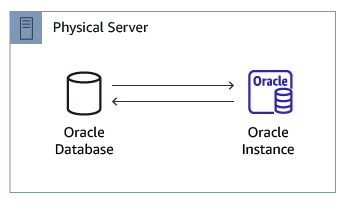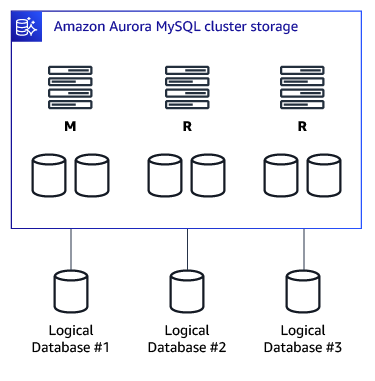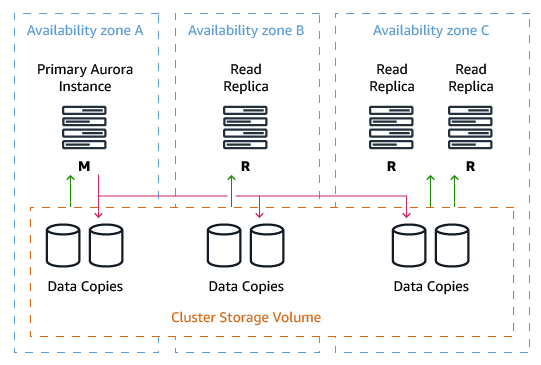Oracle multitenant and MySQL databases
With Amazon DMS, you can migrate Oracle multitenant databases and MySQL databases to Amazon Aurora.
| Feature compatibility | Amazon SCT / Amazon DMS automation level | Amazon SCT action code index | Key differences |
|---|---|---|---|
|
|
N/A |
N/A |
Distribute load, applications, and users across multiple instances. |
Oracle usage
Oracle 12c introduces a new multitenant architecture that provides the ability to create additional independent pluggable databases under a single Oracle instance. Prior to Oracle 12c, a single Oracle database instance only supported running a single Oracle database as shown in the following diagram.

Oracle 12c introduces a new multitenant container database (CDB) that supports one or more pluggable databases (PDB). The CDB can be thought of as a single superset database with multiple pluggable databases. The relationship between an Oracle instance and databases is now 1:N.

Oracle 18c adds following multitenant related features:
-
DBCA PDB Clone — UI interface which allows cloning multiple pluggable databases (PDB).
-
Refreshable PDB Switchover — An ability to switch roles between pluggable database clone and its original primary.
-
CDB Fleet Management — An ability to group multiple container databases (CDB) into fleets that can be managed as a single logical database.
Oracle 19 introduced support to having more than one pluggable database (PDB) in a container database (CDB) in sharded environments.
Advantages of the Oracle 12c multitenant architecture
-
You can use PDBs to isolate applications from one another.
-
You can use PDBs as portable collection of schemas.
-
You can clone PDBs and transport them to different CDBs/Oracle instances.
-
Management of many databases (individual PDBs) as a whole.
-
Separate security, users, permissions, and resource management for each PDB provides greater application isolation.
-
Enables a consolidated database model of many individual applications sharing a single Oracle server.
-
Provides an easier way to patch and upgrade individual clients and/or applications using PDBs.
-
Backups are supported at both a multitenant container-level as well as at an individual PDB-level (both for physical and logical backups).
The Oracle multitenant architecture
-
A multitenant CDB can support one or more PDBs.
-
Each PDB contains its own copy of
SYSTEMand application tablespaces. -
The PDBs share the Oracle Instance memory and background processes. The use of PDBs enables consolidation of many databases and applications into individual containers under the same Oracle instance.
-
A single Root Container (CDB$ROOT) exists in a CDB and contains the Oracle Instance Redo Logs, undo tablespace (unless Oracle 12.2 local undo mode is enabled), and control files.
-
A single Seed PDB exists in a CDB and is used as a template for creating new PDBs.

CDB and PDB semantics
Container databases (CDB)
-
Created as part of the Oracle 12c software installation.
-
Contains the Oracle control files, its own set of system tablespaces, the instance undo tablespaces (unless Oracle 12.2 local undo mode is enabled), and the instance redo logs.
-
Holds the data dictionary for the root container and for all of the PDBs.
Pluggable databases (PDB)
-
An independent database that exists under a CDB. Also known as a container.
-
Used to store application-specific data.
-
You can create a pluggable database from a the
pdb$seed(template database) or as a clone of an existing PDB. -
Stores metadata information specific to its own objects (data-dictionary).
-
Has its own set of application data files, system data files, and tablespaces along with temporary files to manage objects.
Examples
List existing PDBs created in an Oracle CDB instance.
SHOW PDBS; CON_ID CON_NAME OPEN MODE RESTRICTED 2 PDB$SEED READ ONLY NO 3 PDB1 READ WRITE NO
Provision a new PDB from the template seed$pdb.
CREATE PLUGGABLE DATABASE PDB2 admin USER ora_admin
IDENTIFIED BY ora_admin FILE_NAME_CONVERT=('/pdbseed/','/pdb2/');
Alter a specific PDB to the READ/WRITE mode and verify the change.
ALTER PLUGGABLE DATABASE PDB2 OPEN READ WRITE; SHOW PDBS; CON_ID CON_NAME OPEN MODE RESTRICTED 2 PDB$SEED READ ONLY NO 3 PDB1 READ WRITE NO 4 PDB2 READ WRITE NO
Clone a PDB from an existing PDB.
CREATE PLUGGABLE DATABASE PDB3
FROM PDB2 FILE_NAME_CONVERT= ('/pdb2/','/pdb3/');
SHOW PDBS;
CON_ID CON_NAME OPEN MODE RESTRICTED
2 PDB$SEED READ ONLY NO
3 PDB1 READ WRITE NO
4 PDB2 READ WRITE NO
5 PDB3 MOUNTED
For more information, see Oracle Multitenant
MySQL usage
Amazon Aurora MySQL offers a different and simplified architecture to manage and create a multitenant database environment. You can use Aurora MySQL to provide levels of functionality similar but not identical to those offered by Oracle PDBs by creating multiple databases under the same Aurora MySQL cluster and / or using separate Aurora clusters if total isolation of workloads is required.
You can create multiple MySQL databases under a single Amazon Aurora MySQL cluster.

Each Amazon Aurora cluster contains a primary instance that can accept both reads and writes for all cluster databases.
You can create up to 15 read-only nodes providing scale-out functionality for application reads and high availability.

An Oracle CDB/Instance is a high-level equivalent to an Amazon Aurora cluster, and an Oracle Pluggable Database (PDB) is equivalent to a MySQL database created inside the Amazon Aurora cluster. Not all features are comparable between Oracle 12c PDBs and Amazon Aurora.
Starting with Oracle 18c and 19c, you can use this feature for the following:
-
PDB Clone
-
Refreshable PDB Switchover
-
CDB Fleet Management
-
More than one pluggable database (PDB) in a container database (CDB) in sharded environments.
In the Amazon Cloud, these features can be achieved in many ways and each can be optimized using different services.
Cloning databases inside the MySQL instance is not so easy. For the same instance, you can use export and import.
To achieve similar functionality to Refreshable PDB Switchover, it depends on the use case but there are multiple options mostly depended on the required granularity:
-
Databases in the same instance — you can do the failover using
CREATE DATABASEstatement when size and required downtime allow that and use an application failover to point to any of the databases. -
Database links and replication method — database links or Amazon DMS can be used to make sure there are two databases in two different instances that are in sync and have application failover to point to the other database when needed.
Managing CDB is actually very similar to the Amazon orchestration, as you can manage multiple Amazon RDS instances there (CDB) and databases inside (PDB), all monitored centrally and can be managed through the Amazon console or Amazon CLI.
Examples
Create a new database in MySQL using the CREATE DATABASE statement.
CREATE DATABASE db1; CREATE DATABASE db2; CREATE DATABASE db3;
List all databases created under an Amazon Aurora MySQL cluster.
SHOW DATABASES; Database information_schema mysql performance_schema db1 db2 db3 sys tmp
Independent database backups
Oracle 12c provides the ability to perform both logical backups using DataPump and physical backups using RMAN at both the CDB and PDB levels. Similarly, Aurora MySQL provides the ability to perform logical backups on all or a specific database using mysqldump. However, for physical backups when using snapshots, the entire cluster and all databases are included in the snapshot. Backing up a specific database with in the cluster is not supported.
This is usually not a concern because volume snapshots are extremely fast operations that occur at the storage infrastructure layer, incur minimal overhead, and operate at extremely fast speeds. However, the process of restoring a single MySQL database from an Aurora snapshot requires additional steps such as exporting the specific database after a snapshot restore and importing it back to the original Aurora cluster.
For more information, see CREATE DATABASE Statement
